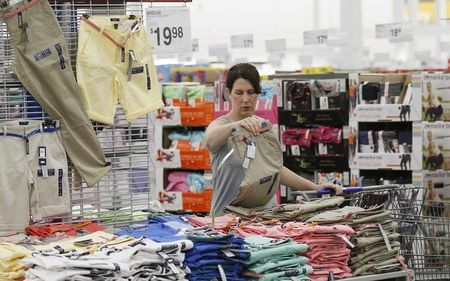By Lucia Mutikani
WASHINGTON (Reuters) - A gauge of U.S. consumer spending rose solidly in June, in the latest indication that the economy ended the second quarter on a stronger footing.
That momentum appeared to have carried into the third quarter, with another report on Tuesday showing factory activity in New York state expanded sharply in July.
"This is not a fragile economy," said Chris Rupkey, chief financial economist at Bank of Tokyo-Mitsubishi UFJ in New York. "The consumer continues to play their part in moving the economy forward."
Core sales, which strip out automobiles, gasoline, building materials and food services, increased 0.6 percent last month after rising an upwardly revised 0.2 percent in May, the Commerce Department said.
Core sales, which correspond most closely with the consumer spending component of gross domestic product, were previously reported as being flat in May. Economists had expected them to rise 0.5 percent in June.
The report added to signs of the economy's strengthening fundamentals, which could buoy optimism the recovery is on a self-sustaining path, after output contracted sharply in the first quarter.
Federal Reserve Chair Janet Yellen told lawmakers the economy continued to improve, but noted that the recovery was not yet complete because of still-high unemployment.
Yellen, however, cautioned the U.S. central bank could raise interest rates sooner and more rapidly than currently envisioned if the labor market continued to improve faster than anticipated by policymakers.
Labor market conditions are firming, with the unemployment rate falling to a near six year-low of 6.1 percent in June and job growth exceeding 200,000 for a fifth straight month.
Prices for U.S. Treasury debt fell on the economic data and Yellen's interest rate comments, while the dollar gained against a basket of currencies. U.S. stocks traded lower.
June's gains and May's upward revision to core retail sales suggested a pickup in consumer spending in the second quarter after growing at its slowest pace in more than four years in the first quarter because of weak healthcare consumption.
Forecasting firm Macroeconomic Advisers raised its second-quarter GDP growth forecast by three-tenths of a percentage point to a 3.0 percent annual pace. Goldman Sachs upped its estimate for the quarter by two-tenths to a 3.4 percent rate.
UPBEAT OUTLOOK
A surprise drop in receipts for automobiles, however, held overall retail sales to a 0.2 percent increase in June after advancing 0.5 percent the prior month.
"Consumers will likely gain more confidence to spend as the job market improves and summer travel season hits full swing," said Randy Hopper, credit cards vice president at Navy Federal Credit Union in Vienna, Virginia.
"We are optimistic that the second half of the year will deliver stronger sales growth."
From employment to manufacturing, the economy appears to be firing on nearly all cylinders, with even housing regaining its footing after slumping in late 2013 following a run-up in mortgage rates. Growth estimates for the second quarter top a 3.0 percent annual rate.
In another report, the New York Fed said its Empire State general business conditions index jumped to 25.60 this month, the highest since April 2010, from 19.28 in June.
New orders edged up, while factory employment and shipments surged. There were also signs of inflation pressures, with measures of both prices received and paid by manufacturers rising in July.
Overall retail sales in June were restrained by a 0.3 percent fall in receipts at auto dealerships. The decline is surprising given automakers reported a surge in motor vehicle sales in June.
Auto sales had increased 0.8 percent in May. Excluding autos, sales grew 0.4 percent after rising by the same margin in May. There were increases in sales at non-store retailers, which include online sales, as sales at clothing retailers.

Receipts at sporting goods shops rose as did those at electronics and appliances stores. But sales at building materials and garden equipment suppliers fell 1.0 percent.
(Reporting by Lucia Mutikani, additional reporting by Rodrigo Campos in New York; Editing by Meredith Mazzilli)
